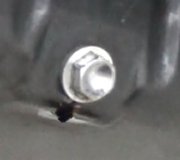Remember there are over 2,000 defects the Engine Computer can detect. One of them is a "small leak" in the fuel vapor recovery system, and one is a "gross leak" in that system. A loose gas cap is just one of many possible causes of those fault codes.
There's two ways the vehicle's emissions are measured. One is the composition of gases leaving the tail pipe while the engine is running. Those are what is measured when the vehicle goes through the state inspection. The second way is the vehicle is placed in an air-tight room, then the air in that room is sampled a specific amount of time later. Interior fabric for seats, carpet, and especially head liners produce "off-gasing" which contributes to harmful emissions. The industry is more worried about fuel that vaporizes in the gas tank, then leaks out to the environment. Starting with '96 models, the tank and fuel supply systems are sealed, and every manufacturer has their way of measuring pressure or vacuum in the tank, then watching to see if that changes too quickly, indicating a leak.
Out of those 2,000 potential defects the Engine Computer can detect, about half of them refer to things that could increase the amount of bad stuff that leaves the tail pipe, or the amount of fuel vapors that sneak out of the fuel supply system. Chrysler started controlling those vapors in the late 1960s. A few years later they added a charcoal canister to absorb the gas vapors that formed in the top of the gas tank. Those vapors are drawn out and burned when the engine is running. Today that system is monitored to be sure no vapors leak into the atmosphere. That's where the loose gas cap is detected.
If you tighten the gas cap until it clicks, it is tight enough. There's no need to remove it first. There is a vent in the cap to allow air to enter the tank as the fuel is used up. It's that vent that typically fails to seal, and allows vapors to leak out.
Also be aware a leaking gas cap is responsible for a leak in this system perhaps five percent of the time. It is much more common to have a loose or rusted hose clamp, a dry-rotted hose, or a leaking computer-controlled valve that lets vapors leak out. Because it can be almost impossible to figure out what is leaking with a visual inspection, a new tool was developed to help with that. It is a "smoke machine" that develops a white, non-toxic smoke at two pounds of pressure. We inject that into the system, then wait and watch to see where it is sneaking out. For most of those leaks, even once you know where it is, you still can't see what is wrong. Most repairs involve replacing a hose, a hose clamp, a gas cap, or most commonly, a valve. Tightening the gas cap is the only one of those you can try yourself.
The loose gas cap will never cause a flashing Check Engine light. The cap is part of the system that involves vapors being given off when the vehicle is sitting. The flashing Check Engine light refers to excessive pollutants going out the tail pipe that are caused by too much unburned gas going into the engine while it's running. Lots of things cause tail pipe emissions to increase, and those are the 1,000 or so fault codes that turn on the Check Engine light. Only a few of those things are caused by too much unburned gas going into the exhaust system. Those are the things that cause the light to flash.
For the states that require emissions inspections, they used to measure and analyze what was coming out of the tail pipe, and that was it. Once a model was approved for manufacture, the off-gasing of individual cars was not measured. The '96 and newer models do that for us with that fuel vapor recovery system that can detect a leak, including from a loose gas cap. Instead of the inspector looking for a leak, he is looking to see the computer has not detected a leak. The simple absence of a diagnostic fault code is all that's needed to pass the test, but that still has never addressed the gases coming from the interior fabrics and material. It is assumed if that is held to acceptable limits on a few random test models, it will be the same for all the other cars of that model, and unlike emissions-related problems that can develop on individual cars, off-gasing of interior components will only decrease over time.
Tuesday, January 30th, 2018 AT 3:59 PM


